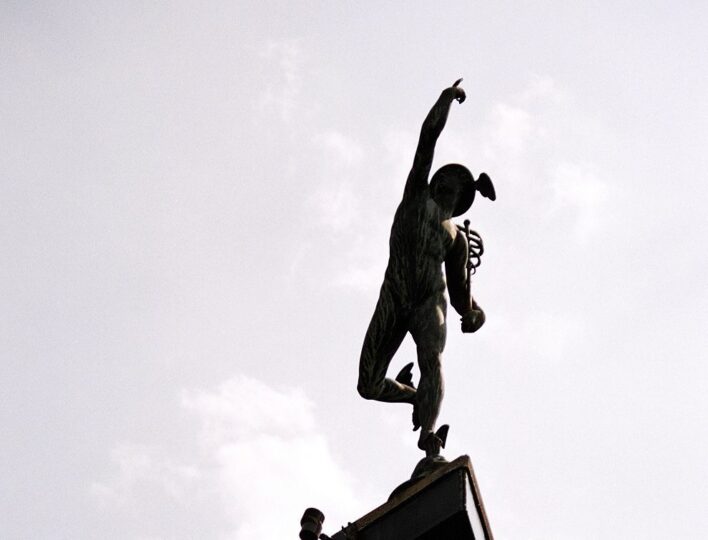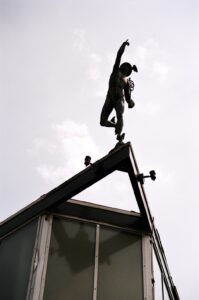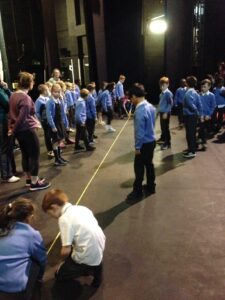
Claire and Laura from Mercury Voices describe what happened when they asked how the Mercury Theatre archive could be used in a local history study for primary aged pupils.
PS. Learn more about Mercury Voices at our FREE Heritage Open Day on Sat 8 September!
“An amazing way to learn about history of theatre in our town and an opportunity to encourage everyone to look high and low for historic clues about the local area in which we live” Class teacher
“My trip to the Mercury theatre was outstanding!” Nick
We have been busy on the Mercury Voices project compiling, cataloguing and caring for the archive of the Mercury Theatre and Colchester Repertory Company Theatre before it. Since the project began in January 2017 we have found plenty of evidence not only relating to the performances and performers at the theatre, but also of the various buildings, locations, and significant people in the theatre’s history. We’ve been exploring these stories in our exhibitions in the Digby Gallery and at touring destinations such as Colchester Library and Essex Record Office in Chelmsford, but felt there was also an opportunity to share with schools coming to the theatre for an educational visit.
Working closely with Rebecca Hall, the theatre’s Learning and Schools Producer, we trialled a learning session with a local school to think about the place theatre has in our town and were blessed with a beautifully sunny day when the class visited in March.
We started by standing outside the theatre to see if anyone had noticed the curious looking figure who stands on the top. Some of the children had already seen the statue on their arrival and were keen to share their ideas about who it could be and why he would need winged boots, a winged hat and a snaky winged staff. We decided that this was a statue of Mercury, standing on top of the theatre ready to fly off to deliver any messages in his role as Roman god of communication.
“I liked learning about Mercury and how he delivered messages and how he loved the theatre.” Harry P

When the theatre was built in its current location in the early 1970s the name Mercury was suggested by readers of the local paper as fitting for a theatre in a Roman town. More than twenty years before this a small bronze of Mercury was found near the site of a Roman theatre in Gosbecks and a copy of this is in the theatre foyer and the original in the Castle Museum. The statue we can see on top of the building today is a copy of one created by Renaissance artist Giambologna that was bought at an auction by David Forder and Bernard Mason for £710.
As we were standing beside the Roman wall there was an opportunity to briefly describe Colchester as a Roman town with many people looking for things to do as entertainment just as today. It was also a chance to remind the children that when you know a place you can easily walk past without really looking or asking questions and that their visit was about those things – looking all around for clues about Colchester’s past.
From the Mercury Theatre we made our way to the Albert Hall, location of the Colchester Rep from 1937 to 1972 and now the Co-operative Bank in Colchester’s High Street. The children started to notice the architecture and design features of the building which was originally intended as a new corn exchange. They felt it was a grand building with a serious purpose, reflected in the stepped entrance to arched windows and doors and classical columns with Ionic capitals (look out for the sheaves of corn). You can just about spot the entablature and Colchester coat of arms (the cross and three crowns supported by nails) that crops up all around town on bus stops and bins, although to get a safe view you need to stand on the other side of the road. Originally there would also have been two relief sculptures with an agricultural theme which have been removed to St Mary’s car park near the Mercury Theatre. Next time we’ll challenge the class to spot them from across the road when we get back to the theatre.
The Albert Hall has been used variously as a corn exchange, art gallery, public hall, school and assembly room, before its use as a theatre. We discussed what a building needs to be a theatre and showed photos of the Albert Hall in its Rep days to explore how successful this building was as a theatre and why the Rep moved.
“I learned that the bank was a theatre and it had a little stage” Amelia P
We left the Albert Hall to make our last stop which was also our furthest back in time. One of Colchester’s two Roman theatres is in Maidenburgh Street and its foundations are marked out on the pavement in a different coloured brick. The Museum Service opened the building for us to have a closer look at the archaeology and to consider the size of this structure compared with more modern theatres. This theatre could accommodate an audience of approximately 2000 people in 2nd century Camulodunum. We discussed why the Romans thought it was important to have a theatre, where the stage was, and importantly what it would be like to come to an open air theatre in Britain.
Colchester had two theatres during the Roman period, and two of only five known in the country. This shows us how significant Colchester was to the Romans and also about the role of theatre in their lives. By now we could start to make comparisons with the other theatres we’d explored on the visit, from the audience and stage size, the layout of the auditorium, to the state of the toilets.
We returned to the Mercury Theatre along the High Street, but this time on the opposite side of the road to observe the Grand Theatre, opened in 1905 and now a nightclub. A quick pause here allowed us to comment on how theatre faired once cinema arrived in the 20th century. The Grand was built as a theatre but quickly became a cinema along with The Playhouse, another theatre built in 1929 and converted to a cinema just a year later.
Back at the Mercury the children were able to use stage plans from the archive to map the Albert Hall stage directly onto the modern stage and mark out the size and shape by standing around the perimeter. This required some calculation skills as the measurements on the old plans were all given in feet and inches. Standing on the modern stage we discussed the effect of the size and shape of the stages on the production of the play and the audience experience. We supported this with production photos of early Rep shows, showing the actors effectively in a straight line along the narrower stage.
“I liked it when we all went onto the stage and found out long and wide the Albert Hall was” Amelia S
We rounded the session up with an observational drawing of Mercury himself which was very popular with the children. “I never knew I could draw so well” said William. There was also a chance to visit the Digby Gallery exhibition about the Repertory Company which Emelia particularly liked:
“My favourite part was the exhibition bit because we learned about Robert Digby and Beatrice Randall [Radley] and that they built a company”
There was just time before leaving to listen to an oral history recording given by Paul Warner, whose spanners were used to secure the Mercury statue in place, which brought us back to the beginning with Mercury on top of the building and the children with new knowledge and skills.
If you are interested in knowing more about this session or would like to discuss how you can use the Mercury Voices archive as a learning resource please contact Mercury Voices and Rebecca Hall on [email protected] and [email protected]
Newer Blog Post Older Blog Post Back to Blog


